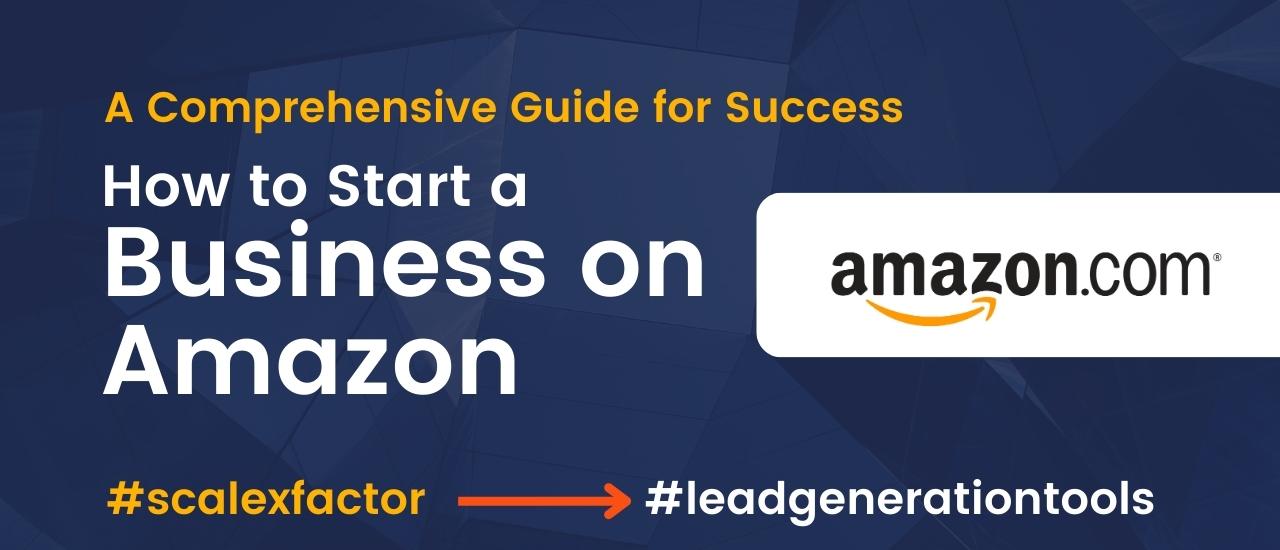Are you eager to embark on an exciting entrepreneurial journey and start your own business on Amazon? The world of e-commerce offers countless opportunities, and Amazon, being one of the largest online marketplaces, provides an ideal platform for aspiring entrepreneurs.

In this comprehensive guide, we will walk you through the process of starting a business on Amazon, from the initial steps to scaling your venture with the power of lead generation tools with the ScaleXFactor. So, fasten your seatbelt as we dive into the world of Amazon entrepreneurship!
Table of Contents
| Sr# | Headings |
|---|---|
| 1 | Introduction |
| 2 | Understanding the Amazon Marketplace |
| 3 | Choosing the Right Business Model |
| 4 | Researching and Selecting Profitable Niches |
| 5 | Setting Up Your Amazon Seller Account |
| 6 | Sourcing Products and Inventory Management |
| 7 | Creating an Optimized Product Listing |
| 8 | Mastering Amazon SEO for Visibility |
| 9 | Leveraging Social Media for Marketing |
| 10 | Building Your Brand Identity |
| 11 | The Power of Lead Generation |
| 12 | Delivering Excellent Customer Service |
| 13 | Handling Fulfillment and Logistics |
| 14 | Expanding to International Markets |
| 15 | Scaling Your Business with ScaleXFactor |
| 16 | Conclusion |
| 17 | FAQs |
1. Introduction
Starting a business on Amazon can be an exhilarating and rewarding experience. With millions of potential customers at your fingertips, the opportunities seem boundless. In this article, we will guide you through the essential steps to establish your Amazon business successfully. Whether you’re a seasoned entrepreneur or a newcomer to the e-commerce world, this guide will equip you with the knowledge and strategies needed to thrive on Amazon.
2. Understanding the Amazon Marketplace
Before diving into the intricacies of Amazon selling, it’s crucial to understand how the marketplace operates. Amazon offers two primary seller options: Individual and Professional accounts. Each account type has its own benefits and limitations. Familiarize yourself with Amazon’s fees, policies, and customer expectations to make informed decisions that align with your business goals.
3. Choosing the Right Business Model
Amazon provides various business models, such as Private Labeling, Retail Arbitrage, and Wholesale. Each model offers unique advantages and requires different approaches. Analyze your resources, preferences, and long-term objectives to select the most suitable business model for your venture.
4. Researching and Selecting Profitable Niches
Finding the right niche is paramount to your success on Amazon. Conduct thorough market research to identify high-demand products with manageable competition. Utilize tools and data analysis to validate your niche choices and avoid potential pitfalls.
5. Setting Up Your Amazon Seller Account
To begin selling on Amazon, you need to set up a seller account. Follow the step-by-step process provided by Amazon to create either an Individual or Professional seller account. Complete the necessary verification and tax information to get your business up and running.
6. Sourcing Products and Inventory Management
Finding reliable suppliers and managing your inventory efficiently are critical aspects of running a successful Amazon business. Explore different sourcing options, negotiate pricing, and maintain an optimized inventory system to ensure a smooth selling process.
7. Creating an Optimized Product Listing
Your product listing is your virtual storefront on Amazon. Optimize your listing with compelling product titles, informative descriptions, high-quality images, and appropriate keywords. A well-optimized listing increases visibility and attracts potential customers.
8. Mastering Amazon SEO for Visibility
Amazon’s search algorithm plays a crucial role in product discoverability. Understand the importance of Amazon SEO and how to optimize your listings to rank higher in search results. Strategic use of keywords, backend search terms, and customer reviews can significantly impact your product’s visibility.
9. Leveraging Social Media for Marketing
Social media platforms provide an excellent opportunity to engage with your audience, build brand awareness, and drive traffic to your Amazon listings. Craft a social media marketing strategy that resonates with your target customers and encourages them to explore your products on Amazon.
10. Building Your Brand Identity
Establishing a strong brand identity sets you apart from competitors and fosters customer loyalty. Design a compelling brand logo, create a brand story, and maintain consistent branding across all platforms. Building a recognizable brand identity enhances your credibility and fosters trust among customers.
11. The Power of Lead Generation
Lead generation is a fundamental aspect of business growth. Learn effective lead generation strategies to expand your customer base, nurture relationships, and boost sales. Implement tactics like lead magnets, email marketing, and personalized offers to convert leads into loyal customers.
12. Delivering Excellent Customer Service
Customer satisfaction is vital for long-term success on Amazon. Prioritize exceptional customer service, respond promptly to inquiries, and resolve issues with empathy and professionalism. Positive reviews and word-of-mouth referrals can significantly impact your business’s reputation.
13. Handling Fulfillment and Logistics
Efficient fulfillment and logistics are essential for maintaining a seamless order fulfillment process. Choose between Fulfillment by Amazon (FBA) or Fulfillment by Merchant (FBM) based on your business needs. Streamline your shipping process to ensure timely deliveries and customer satisfaction.
14. Expanding to International Markets
Expand your Amazon business beyond borders and tap into international markets. Research market trends, cultural differences, and legal requirements before entering new territories. Tailor your marketing and branding strategies to resonate with diverse audiences.
15. Scaling Your Business with ScaleXFactor
To achieve substantial growth, leverage the ScaleXFactor – a combination of innovative tactics to amplify your business success. Embrace automation, outsource non-core tasks, and explore strategic partnerships to scale your Amazon business effectively.
16. Conclusion
Starting and growing a business on Amazon demands dedication, strategic thinking, and adaptability. As you progress on your entrepreneurial journey, stay updated with Amazon’s policies, industry trends, and customer preferences. Remember that success may not come overnight, but with perseverance and continuous improvement, your Amazon business can flourish and thrive.
FAQs
- What are the initial costs involved in starting an Amazon business?
Starting an Amazon business entails various costs, including product sourcing, inventory storage, Amazon seller fees, and marketing expenses. - How can I handle negative feedback or reviews on Amazon?
Address negative feedback promptly and professionally. Resolve any issues, offer solutions, and demonstrate your commitment to excellent customer service. - Can I sell in multiple Amazon marketplaces simultaneously?
Yes, Amazon allows sellers to expand their reach by selling in multiple international marketplaces. However, it requires careful planning and compliance with different regulations. - What is the best approach to pricing my products on Amazon?
Pricing strategies vary based on your business model, product niche, and competition. Conduct market research and analyze your costs to set competitive and profitable prices. - How do I protect my brand from counterfeiters on Amazon?
Enroll in




